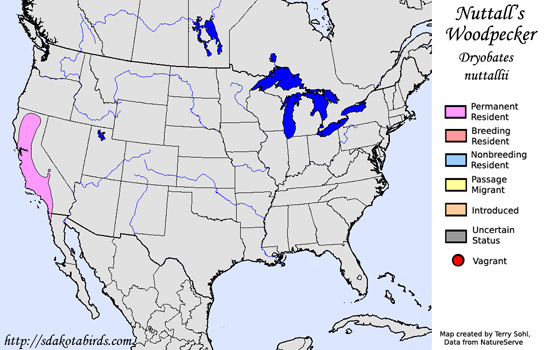Nuttall's Woodpecker
Dryobates nuttallii
| Length: 7.5 inches | Wingspan: 13 inches | Seasonality: Non-resident in South Dakota |
| ID Keys: Black and white barring on back, white underparts with dark spots, black face with white "eyebrow" and "mustache" | ||
 The
Nuttall's Woodpecker is a bird of California and the northern part of Baja
California, where they are permanent residents. They are most commonly
seen in areas of many oak trees, where numbers of the bird may be relatively
high. They are very close relatives of the
Ladder-backed Woodpecker,
with an appearance that is very similar. They both have similar facial
patterns, but the Nuttall's has much more black on the face, and the red
crown on the male is much less extensive than the Ladder-backed Woodpecker.
The two species do overlap in range at the far southeastern edge of their
range, where Nuttall's Woodpeckers may come into contact with Ladder-backed
Woodpeckers in dry mesquite habitats. Where the ranges overlap,
interbreeding between the two species has been noted. They have also
been recorded as hybridizing with Downy
Woodpeckers on occasion.
The
Nuttall's Woodpecker is a bird of California and the northern part of Baja
California, where they are permanent residents. They are most commonly
seen in areas of many oak trees, where numbers of the bird may be relatively
high. They are very close relatives of the
Ladder-backed Woodpecker,
with an appearance that is very similar. They both have similar facial
patterns, but the Nuttall's has much more black on the face, and the red
crown on the male is much less extensive than the Ladder-backed Woodpecker.
The two species do overlap in range at the far southeastern edge of their
range, where Nuttall's Woodpeckers may come into contact with Ladder-backed
Woodpeckers in dry mesquite habitats. Where the ranges overlap,
interbreeding between the two species has been noted. They have also
been recorded as hybridizing with Downy
Woodpeckers on occasion.
Habitat: Found in deciduous forests and woodlands, especially forested areas with oak trees. In drier parts on the edge of their range, they may also use mesquite habitats.
Diet: Feeds mostly on insects, but will also feed on nuts, seeds, fruits, and berries.
Behavior: Forages in trees with a dense canopy, moving deliberately across the branches in search of insects. They will also sometimes fly out to catch insects in mid-air.
Nesting: The nest of a Nuttall's Woodpecker is a cavity, built in a live tree, dead tree, or sometimes in a man-made object like a fence post or telephone pole. The female lays 3 to 4 eggs, with both parents helping to incubate the eggs. After the eggs hatch, both parents help to feed the young.
Song: The drumming of a Nuttall's Woodpecker is a steady series of taps, lasting quite long. A contact call is a crisp 2- to 3-note pitik, while the rattle call is a steady pitikikik.
Migration: Considered a permanent resident throughout their range. Individual birds rarely wander far from breeding sites.
Interactive eBird Map: Click here to access an interactive eBird map of Nuttall's Woodpecker sightings
Similar Species: Extremely similar to the Ladder-backed Woodpecker, but the ranges of the two species only slightly overlap. Also similar to the Downy Woodpecker.
Feeders: Will attend feeders for various seeds, nuts, fruits, and suet.
Conservation Status: Populations appear to be stable, and the IUCN lists the Nuttall's Woodpecker as a species of "Least Concern".
Further Information: 1) National Geographic - Nuttall's Woodpecker
2) WhatBird - Nuttall's Woodpecker
3) Audubon Guide - Nuttall's Woodpecker
Photo Information: Photo taken by Mike Baird - May 23rd, 2007 - Morro Bay, California - Photo licensed under Creative Commons Attribution 2.0 Generic License
| Click below for a higher-resolution map |
 |
| South Dakota Status: Non-resident in South Dakota |
Additional Nuttall's Woodpecker Photos (coming soon!!)
